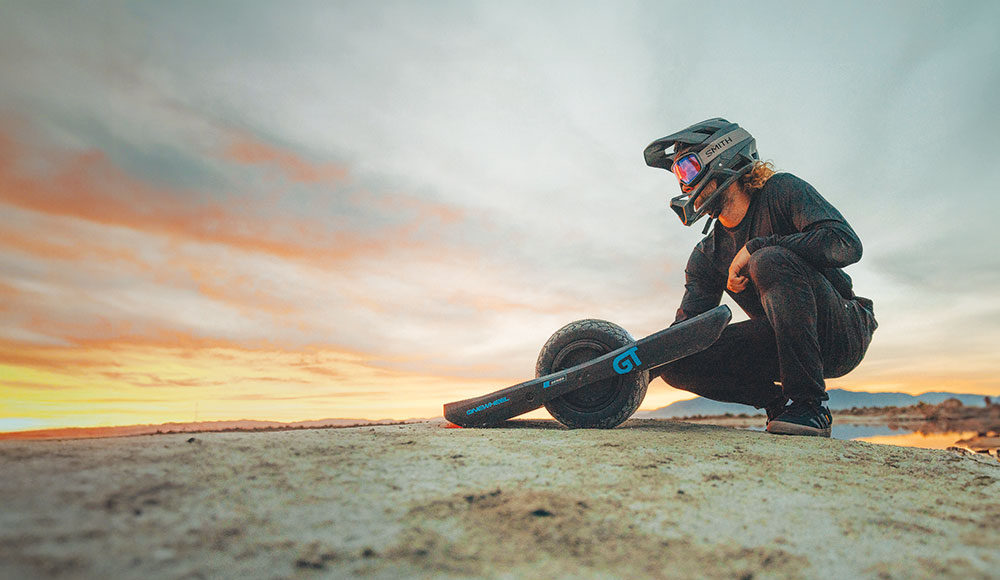Kyle Doerksen wanted to build something that simulated the feel of snowboarding, but on pavement. A self-balancing board to glide you away into serenity.
“It was just me trying to make something for myself and was not a commercial project,” Doerksen says. “Then I had a couple of friends that were like, ‘Whoa, this is a really cool experience—can you build one for me?’”
Doerksen grew up in Calgary, Canada, and moved to the U.S. in the early 2000s to attend college. While doing his undergraduate studies in neuroengineering at Stanford University, he discovered his passion for the hands-on aspect of the field and left college with a master’s degree in mechanical engineering. After an eight-year stint with IDEO, a Palo Alto firm that developed products like Apple’s first mouse, Doerksen helped found electric bike company Faraday Bikes.
“Through that experience I got to see the birth of what is now called micro mobility,” Doerksen says. “After tinkering in my garage for a while, I managed to get an early Onewheel prototype going.”
Fitted with a go-kart wheel, a wooden deck and metal sidings, Doerksen says, the early prototype was ahead of its time—before lithium batteries and wheel hub motors—and he had to put it on hold for a few years.
By 2013, the Onewheel was ready to roll out commercially. Doerksen launched a Kickstarter campaign, asking for $100,000 to get the project going. But the success of the campaign hinged on one thing—a standout showing at that 2014 CES show.
The buzz was immediate. Critics and fans raved, setting off a media frenzy over the new “hoverboard.” Within three weeks, the Kickstarter amassed thousands of backers and topped out at $630,000. Now, Doerksen had to make good on their promise and build hundreds of Onewheels.
“It was incredible—no one had seen anything like it,” recalls Jack Mudd, who teamed up with Doerksen that day to help with marketing. “It was featured on all the ‘Best of CES’ things and everyone wanted to come ride it.”
If You Build It, They Will Ride
Now it’s 2024 and the pair are sitting at the massive Future Motion headquarters in Santa Cruz. Doerksen is the founder and CEO, while Mudd has elevated his marketing title to Chief Evangelist. The company and its flagship product are marking a milestone in their mission to make the future rad.
After the Kickstarter launch in 2014, the small team had to get to work. Doerksen set a timeline of eight months to complete the preorders. All of the Onewheels were going to be built right in the San Francisco Bay Peninsula, where the prototype was hatched, instead of exporting production overseas.The first model was simply called the Onewheel. It had a battery range of 4 to 6 miles and a top speed of 13 mph. Then came the Onewheel+, with a slightly better range of 5 to 7 miles and speeds of up to 19 mph.
As the board began to take off, Mudd took off as well. He traveled for months introducing the Onewheel to America. Within a few years it became a cultural phenomenon. To date, he’s gotten some big names to ride it.
“I’ve actually been lucky to ride with all kinds of people. I rode with Steph Curry. Who else? Jimmy Fallon over at 30 Rock in New York City,” Mudd says. Adam Savage of “Mythbusters” fame is also a fan,’ he adds.
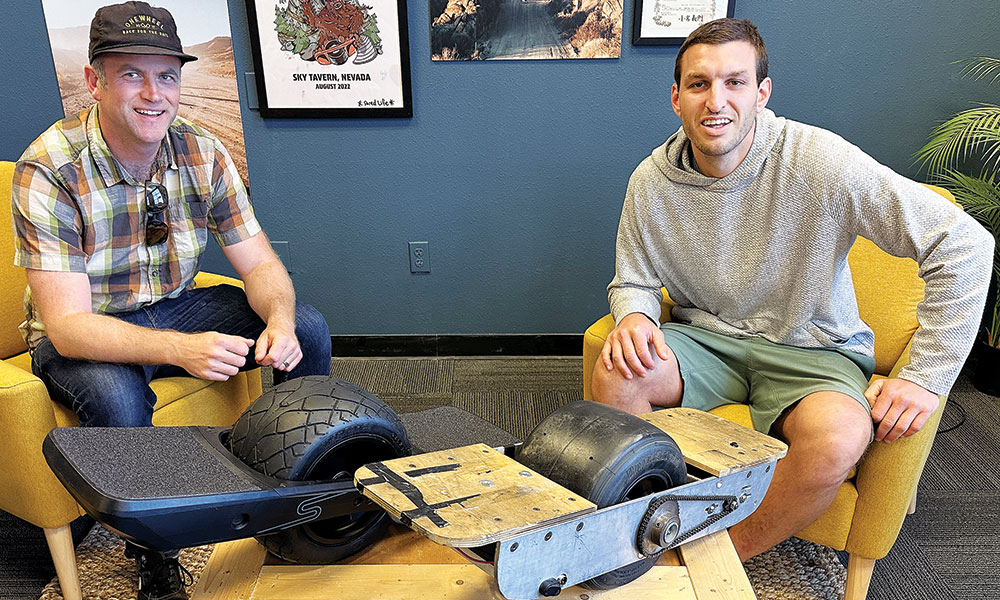

The company has produced seven iterations of the Onewheel, ranging from the smallest versions ( Pint and Pint X), to the newer, beefier GT series. The latest to join the family is the GT S-Series, which is a high-performance model with double the battery voltage of the GT series and a top speed of 25 mph. They range in price from $1,050 for the Pint, up to $3,200 for the GT S-Series.
The boards are controlled by the rider’s body weight, accelerating as the rider leans forward. The faster the lean, the faster it goes.To stop, you just lean back. An accompanying phone app helps customize the experience with “Digital Shaping,” which is comparable to shaping a surfboard for different riding styles.
The Future of Motion
The Future Motion headquarters sits at the end of Schaffer Road on the western edge of Santa Cruz. Large palm trees dot the parking lot leading up to the big, arched entrance of the two-story building emblazoned with the company’s wordmark.
Doerksen and his crew traded the tech-heavy Mountain View for Santa Cruz in 2015. He says that being next to the Google headquarters made everything more expensive and, plus, everyone wanted to be by the beach. The first SC location was at the Wrigley building, the former gum factory-turned business park just down the road from the current base. Santa Cruz Bicycles and LifeAid were neighbors.They moved their production to north San Jose to meet the increased demand and employ dozens of workers at their factory.
My photographer, Tarmo, and I visited the sprawling Santa Cruz facility on a sunny Wednesday in May. The building serves as the hub for the engineering, marketing and customer support operations. As Doerksen pointed out all the memorabilia around us, Mudd rode up on his board: “Are we gonna get you on some Onewheels today?”
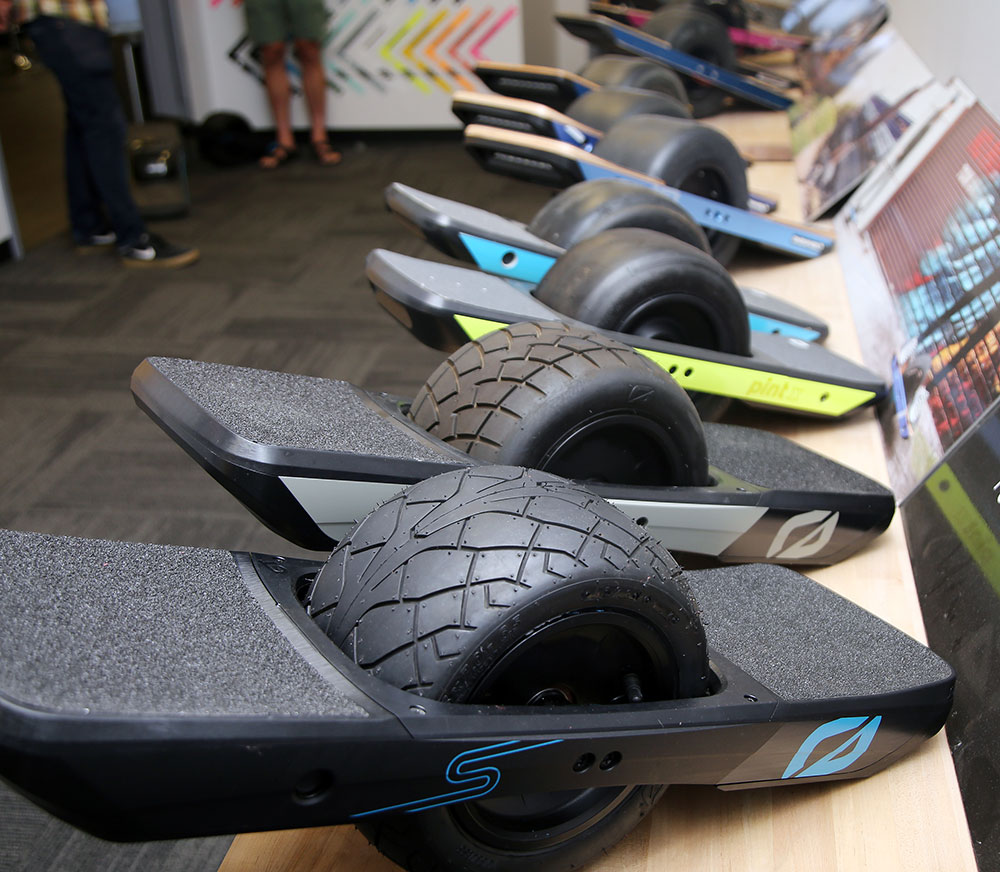

As we sat down to chat, the question lingered in my mind. I found myself more excited than I had anticipated at the prospect of riding a board for the first time.
But I also had questions that weren’t as fun to contemplate. So, after a while of relaxed banter, I addressed the “elephant on the Onewheel.”
“Let’s talk about the lawsuits and the safety concerns.”
Pushing the Limits
Future Motion and Onewheel made headlines in late September 2023 when, at the behest of the U.S. Consumer Product Safety Commision, the company recalled 300,000 units due to safety concerns.
“Future Motion has received dozens of reports of incidents involving the electric skateboards, including four reported deaths between 2019 and 2021 and traumatic brain injuries, concussions, paralysis, upper-body fractures, lower-body fractures and ligament damage. The reported deaths resulted from head trauma and, in at least three of those incidents, the rider was not wearing a helmet. Future Motion and the CPSC encourage all riders to wear personal protective equipment while riding,” read a statement on the CPSC website.
In some cases, Onewheel riders were jettisoned from their board after it abruptly stopped in mid-motion or it no longer self-balanced.
Like any new technology, Onewheel “has an extra layer of scrutiny on it, right?” Doerksen says. “And people are trying to figure out what the product can do, what is the responsibility of the owner and operator. I think it’s fair to say that that’s what we’re in the process of figuring out.”
“It is a board sport,” Mudd adds. “I think people come into it with different sets of expectations. Some people understand that immediately. I snowboard and I understand that when I go snowboarding, if I’m not careful or not doing proper technique, I can fall and get seriously hurt. And I’m okay with that, because the benefits I get from this lifestyle that I live are tremendous.”


The CPSC recall affects the Onewheel GT, Onewheel Pint, Onewheel Pint X and the Onewheel+ XR. The same day the recall was announced, Future Motion introduced a firmware update called “Haptic Buzz” for the models in question in order to address the issues.
All Onewheel models already had a “Pushback” feature, which automatically lifts the nose of the board to alert the rider when they are pushing the device’s limits. Haptic Buzz is a tactile and audio alert modeled after similar alert systems used in the automotive and aviation industries. The board will vibrate and blare out a warning sound when the rider is pushing their Onewheel’s speed limit; accelerating rapidly and exerting considerable torque; or when the battery is low.
In a video uploaded to the Onewheel Youtube channel, Mudd explains the new feature to their 100,000 subscribers.
“Ignoring Pushback or Haptic Buzz can result in serious injury or death,” Mudd says at the end of the clip.
As of June 2024, there were 66 lawsuits relating to Onewheel injuries that had been consolidated into multi-district litigation. Similar to a class action lawsuit, the litigation will bring all the cases to the U.S. District Court for the Northern District of California in front of Judge Beth Labson Freeman later this year. Future Motion might have to settle for a still-undisclosed amount of money as part of the process.
While Doerksen and Mudd can’t comment on the pending litigation, Mudd says that in light of the lawsuits, riders from all over the world penned letters of support for Future Motion.
“We had 5,000 letters from riders in our community explaining what value it brings to them in their daily life. It’s crazy. And this is thousands of people saying ‘This has done so much for my mental health,’” Mudd says.
While some people have had tragic experiences on a Onewheel, others are using the device as a way to heal trauma and improve their state of mind.
Shred the Pain Away
Aaron Knowles has only ever known military life. Both his parents served in the U.S. Air Force, moving the family from base to base. It was a given that he would also follow that path, and at age 19 he enlisted in the U.S. Army. It was the early 2000s, after 9/11. First came the invasion of Afghanistan in 2001. Then, within two years, the larger, more costly invasion of Iraq.
Knowles was deployed to Iraq and was almost killed when an improvised explosive device blew the vehicle he was in off the road. He sustained major injuries and has suffered from PTSD ever since.
“I have physical and mental and emotional wounds that I’m still and forever going to be trying to heal,” Knowles said in a phone interview.
In 2017, Knowles found himself stationed in Florida, feeling overwhelmed and disconnected. He saw someone riding a one-wheeled electric skateboard and it brought him back to his time skateboarding as a child. He knew he had to chase that feeling again.
“As soon as I get on this board and get outside and ride, ride among these groups of riders and have a good time, why is it that I’m just automatically in a better headspace?” he muses.


What Knowles was experiencing is what scientists call the “flow” state.
According to neuroscience researchers, flow is a state of full task engagement accompanied by low levels of self-referential thinking. Flow has been found to relate to mental well-being and physical performance.
“Flow is often associated with athletes, artists, or scientists who are fully task-absorbed in order to achieve peak performance. Yet, flow-like states also occur in more mundane situations, such as when engaging in certain tasks during work or leisure time,” states a 2021 study published by Dutch and South African researchers. “Experiencing flow is accompanied with a sense of accomplishment, meaningfulness and positive mood states.”
After observing his own mood improving the more he rode, Knowles posted in a Onewheel group on Facebook and asked if others were experiencing the same thing. It was a resounding “Yes.”
That’s when Shred the Stress was born. Knowles acquired another Onewheel, and with two boards in tow, set out to give military service members and their families a unique therapeutic experience. He connected with more people on Facebook and started showing up at official Onewheel events to spread the word about his nonprofit. Eventually, Knowles caught the attention of Future Motion. The company donated three boards for his cause; in 2022, he was invited to a demo event in Austin, Texas.
When asked about the lawsuits and recall, Knowles says that, as with any other devices and equipment, there are responsible and irresponsible ways to use the Onewheel. He added that all of the participants in his program wear helmets and protective gear.
“Long story short, I do consider the boards safe and especially so if you follow those guidelines and wear safety gear. Dress for the ride.”
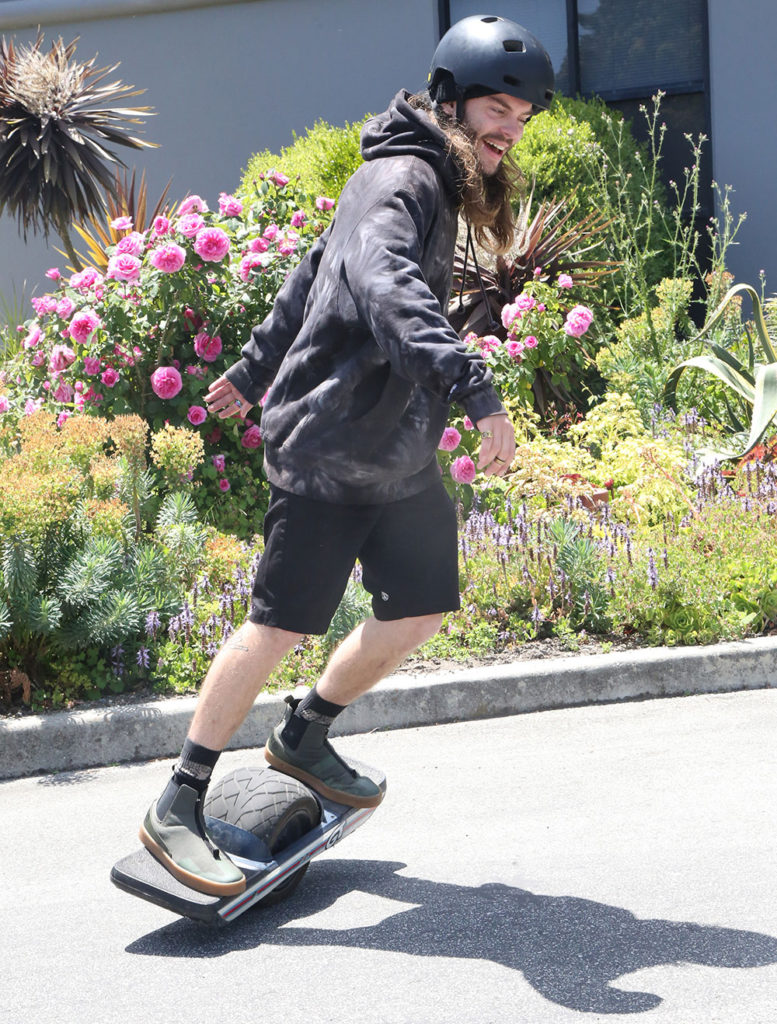

The Future Is Rad
I’m floating through the parking lot and it feels like my brain disappeared from my skull. Well, for a moment.
“See, you were thinking about it,” Mudd says as I start to wobble on the Onewheel.
He was leading me down a slight incline and I started to think if I should accelerate or slow down; if I should lean forward or lean back. Despite that, he said I did pretty well. After The Elephant left the room at the end of our interview, Doerksen and Mudd grabbed some boards and helmets to give us our own private demo.
I was never a great skater, but I found myself wanting to get back on the Onewheel as soon as I got off. Next thing I know, Tarmo is zooming by on another board, being led by Mudd.
Now I’m talking to Bodhi Harrison, Onewheel’s first team rider for the Onewheel Racing League, which has solidified the phenomenon into a board sport. Doeksen and Mudd tell me he is the future of the sport.
“I got into the Onewheel way back in the day right after the Kickstarter launched,” the 25-year-old says.
The Colorado native didn’t just want to ride Onewheel; he wanted to live and breathe it. He moved out to Santa Cruz four years ago to work with Future Motion and has taught clinics, made instructional videos and brought ideas on how to make the products better. In 2017, he was the winner of the inaugural Float Life race in North Carolina. Now, he is pushing the boundaries of the sport.
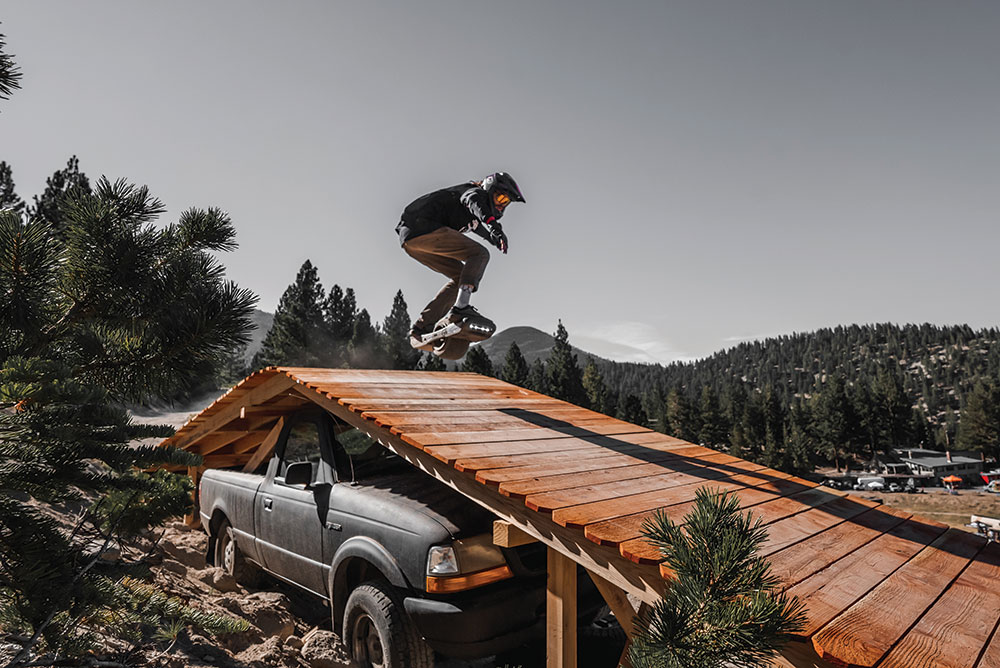

Professional riders like Harrison use the top line of Onewheels, fitted with heavy tread and shaped for maximum power. Races take place on mountain trials and dirtbike tracks, a synthesis of multiple extreme sports.
“The progression that’s happened in the last few years… it really feels like we’re on this tipping point where it’s about to explode and some serious progression with some of the new technology we have to work with,” he says.
In addition to the racing league, a huge online community of freestyle riders has emerged. The Float Life YouTube channel, which is all about customizing and pushing limits of Onewheels. Has over 72,000 subscribers.
“It’s really, truly a medicine and a healthy escape from the heaviness that is life and it brings you into an amazing community and provides you an opportunity to get outside in a fun and really active way,” Harrison says.
“I just want to surf the Earth.”
